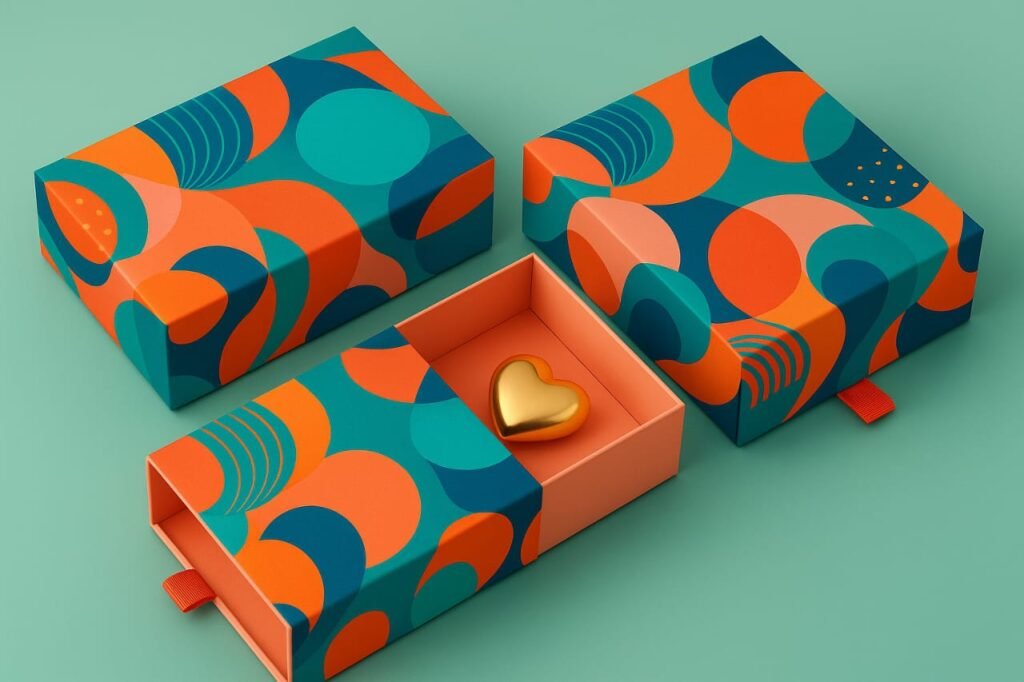
Everything You Need to Know About Sliding Drawer Boxes & Custom Rigid Alternatives
Imagine receiving a gift, pulling gently on a ribbon, and sliding out a hidden tray to reveal the product inside. That’s the magic of a sliding box — also sometimes called a sliding drawer box, slide open box, or in more premium versions, custom sliding drawer rigid boxes. These packaging solutions combine function, surprise, and branding in ways few other box styles can.
This article walks you through:
- What sliding boxes are, and what makes them special
- Types and variations
- Materials, structure, and customization options
- Pros & cons of sliding drawer rigid boxes
- Use cases: when they shine
- Some pricing/production considerations
- Design best practices
What Exactly Is a Sliding Box?
A sliding box is a form of rigid gift or product packaging consisting of two main parts:
- Outer sleeve (rigid shell or cover)— the outer casing
- Inner drawer (tray or matchbox-style slide mechanism)— slides out from one side (or both sides in some designs)
When you open it, you slide the inner tray out of the outer sleeve. The result is often more satisfying, elegant, and protective than a regular lid/two-piece box. It offers not just access, but an experience.
In packaging terminology, sliding boxes are a sub-category of rigid boxes. According to GPrinting, rigid boxes come in types like two-piece boxes, hinged lid boxes, sliding/drawer boxes, collapsible rigid boxes, etc.
Types & Variations of Sliding / Drawer Boxes
Here are some common types of sliding boxes, with different names and structural variations:
| Name / Term | Key Features | Common Materials | Pull / Opening Mechanism |
|---|---|---|---|
| Sliding drawer box | Inner drawer tray slides out of outer sleeve; often premium look | Rigid board, SBS paperboard, chipboard, kraft covers | Ribbon pull, rope pull, finger notch, push from back, no pull (match-style) |
| Slide open box | Another name for sliding drawer box; emphasizes the action of opening | Same variety | Same options |
| Custom sliding drawer rigid boxes | Rigid, high-quality materials; often tailored size, special prints, finishes and inserts | Grey board / rigid cardboard, art paper, textured paper, laminates, etc | Not Applicable |
| Slide & match style boxes | Very similar; “match style” implies like a matchbox where the inner tray fully slides out; often simpler, smaller | Kraft or rigid paperboard | Usually without complicated pulls, maybe thumb notch; clean lines |
So when you see “sliding boxes” or “sliding drawer boxes,” usually those refer to these structures.
Materials, Structure & Customization
For sliding drawer boxes, especially the rigid kind, the structure and materials are essential both for durability and the “premium” feel. Here’s how these are composed:
- Core board / greyboard / chipboard: gives rigidity. Often the main skeleton.
- Outer wrap / cover paper: kraft paper, art paper, textured paper, possibly coated or laminated for finish.
- Inner insert / tray: might be plain tray, a tray with cut-outs (cardboard or foam insert), or more elaborate internal protection.
- Printing and finishes: digital / offset printing, speciality colours (Pantone etc), embossing, debossing, foil stamping, UV or spot UV coatings, gloss/matte finishes.
- Pull mechanisms / opening features: ribbon pull, rope pull, cut notch (thumb notch), push-open or match style. These affect user interaction.
Also, some sliding boxes include a transparent window so the customer can see the product without opening the box. This is especially common for gift boxes or items like jewelry or cosmetics.
Benefits of Sliding Drawer Boxes & Rigid Custom Versions
Why would a brand or product opt for a sliding box? There are many advantages:
1.Unboxing / customer experience
The act of sliding open a drawer feels more luxurious, more interactive. This helps in customer satisfaction, social sharing, and perceived value.
2.Protection
The rigid outer sleeve plus inner tray structure helps protect delicate products from shocks, drops, compression. The drawer mechanism also keeps things more secure than a hinged lid that could flap open.
3.Branding & presentation
Because they’re more visually interesting, sliding boxes contribute a lot toward brand image. You can emboss/foil logos, use special paper, and include inserts that show off the product beautifully.
4.Perceived value & price justification
Products in premium packaging often command a higher price or are perceived as higher quality. That packaging becomes part of what the customer “buys”.
5.Versatility
Sliding drawer box designs can be adapted to many item types: jewelry, cosmetics, electronics, cards / board games, gifts, etc. You pick the size, insert, finish, and get what you need.
6.Eco-friendly possibilities
Many styles now offer kraft paper or recycled board materials, recyclable finishes, minimal plastic. For brands committed to sustainability, this is a way to get premium packaging without completely excessive waste.
Drawbacks / Challenges
Of course, sliding boxes are not perfect in all situations. Some of the drawbacks:
| Challenge | What Makes It More Difficult / Costly |
|---|---|
| Cost of materials and manufacturing | Rigid boards, specialised wraps, finishing techniques (foil, embossing) drive up cost; also more parts (outer sleeve + drawer + insert) than simple flip-top box. |
| Longer production time | More steps: precise die-cutting, folding & gluing, finishing, sometimes custom sample/mock-ups. |
| Minimum order quantities (MOQs) | Many manufacturers require relatively large MOQs to justify setup of dies and tooling. |
| Bulk / shipping costs | Rigid boxes take more space, weight can be higher; shipping to customers or to retailers can be bulkier. |
| Assembly | Some sliding drawer rigid boxes ship flat and require manual assembly/gluing; others may be pre-assembled — which adds cost. |
When Should You Use Sliding Drawer Boxes?
Sliding boxes make sense when your product or brand needs more than just “protection”. Good use-cases include:
- Luxury goods (jewelry, watches, high-end cosmetics)
- Gift products — where presentation is part of the value
- Subscription or premium unboxing boxes — you want the customer to have an experience
- High-visibility retail packaging — shelf appeal matters
- Products that are delicate, need additional protection via inserts (e.g. electronics, glass, fragile goods)
If your product is commodity, low margin, or you need to minimise shipping weight or cost above all else, sliding boxes might be over-engineering.
Design & Cost Components: What Drives Price
If you’re considering using Custom Sliding Drawer Rigid Boxes, here are the levers that affect cost, and what to plan for:
| Factor | Influence on Cost / Lead-Time | What To Ask / Decide |
|---|---|---|
| Material quality / thickness | Thicker rigid board costs more; premium cover papers / special finishes (embossing, foiling) increase cost. | Decide what minimum protection & look you need. |
| Size & complexity | Bigger boxes, unusual shapes, sliding drawers on both sides, multiple compartments/inserts = more complex. | Try to standardise sizes or use simple shapes if cost is a big concern. |
| Finish / printing | Full-color printing, Pantone matching, foil, spot UV, emboss/deboss = costs + setup time. | Know your branding needs; maybe limit to one or two special finishes. |
| Pull / opening mechanism | Ribbon/rope pull adds cost/material; thumb notch or match style less. | Choose based on function + aesthetic vs cost. |
| Insert (foam, cardboard, moulded pulp) | Inserts protect products but add cost / tooling / waste factor. | Use only as needed; sometimes a simple cardboard die-cut insert works well. |
| MOQ & supplier location | Low volumes cost more per unit. Shipping costs vary by origin; international shipping adds duties, lead time. | Get quotes for different volumes; account for shipping and import duties. |
For example: Tycoon Packaging offers custom sliding drawer rigid boxes starting around US$0.50 per box (for certain minimums and basic specs) before finishing / extra features.
Best Practices in Designing Sliding Boxes
If you decide to go with a sliding box for your product, here are design tips to maximize value:
- Right sizing: The drawer should fit snugly inside the sleeve without being too loose (leads to rattling) or too tight (difficult to slide).
- Add inserts wisely: Use die-cut paperboard or recycled pulp inserts instead of foam when possible (cost & sustainability).
- Choose suitable finish: If your target audience likes luxury, finishes like foil stamping, embossing, and soft touch coatings help. But each adds time/cost.
- Pull / opening mechanism ergonomics: Ribbon, rope, thumb notch — make sure it’s comfortable, intuitive.
- Material selection for sustainability: Recycled boards, kraft paper, low VOCinks, recyclable coatings — increasingly important.
- Test with prototypes: Before mass production, get physical mock-ups to check fit, feel, sliding smoothness, durability.
- Clarity in branding & messaging: Make sure the exterior sleeve or drawer has clear branding or visuals, but don’t overlook the interior — even the inside can carry a logo or message.
Case Study Example
Here’s a simplified hypothetical:
Brand X sells handmade jewelry. They want to raise perceived value, reduce breakage during shipping, and get more unboxing shares on social media. They opt for custom sliding drawer rigid boxes: inner tray sized exactly for fixed pieces, ribbon pull, kraft paper outer sleeve with gold foil logo. Inserts are die-cut paperboard. MOQ: 500 units from a supplier. Cost per box: US$1.20 with basic finishes; with foil + embossing goes up to ~$2.00. Increase in customer satisfaction and social media posts, fewer breakages. Retailers give better shelf positioning. Return on investment recouped in increased brand loyalty & reduced returns.
Where to Source & What Questions To Ask Suppliers
If you’re procuring sliding boxes / sliding drawer box packaging / custom sliding drawer rigid boxes, here are key questions to ask suppliers:
- What is your minimum order quantity (MOQ)?
- What material types / thicknesses do you offer, especially for rigid stock?
- What finishing / printing capabilities(foil, embossing, UV, etc.)?
- Can you provide samples or mock-ups?
- What are your lead timesand shipping costs?
- What options for inserts? Paperboard, foam, pulp, etc.
- What environmental credentials do your materials have (recycled content, recyclability, certifications)?
- How will the box perform in transit — drop tests, etc.?
Conclusion
A sliding box (or sliding drawer box / slide open box / custom sliding drawer rigid box) is much more than a container. It’s an experience: an opportunity to protect, present, and elevate your product. While they cost more, both in materials and production, their benefits—brand elevation, protection, unboxing delight—often pay off, especially in luxury, gifting, or e-commerce contexts.
If you’re considering packaging redesign or a premium product launch, sliding drawer rigid boxes are worth serious thought.


